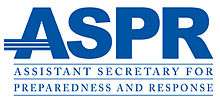Office of the Assistant Secretary for Preparedness and Response
 ASPR Logo | |
| Agency overview | |
|---|---|
| Formed | December, 2006 |
| Preceding agency | |
| Agency executive |
|
| Parent agency | United States Department of Health and Human Services |
| Website | Office of the Assistant Secretary for Preparedness and Response |
The Office of the Assistant Secretary for Preparedness and Response (ASPR) within the United States Department of Health and Human Services was created under the Pandemic and All Hazards Preparedness Act in the wake of Hurricane Katrina to lead the nation in preventing, preparing for, and responding to the adverse health effects of public health emergencies and disasters. ASPR focuses on preparedness planning and response; building federal emergency medical operational capabilities; countermeasures research, advance development, and procurement; and grants to strengthen the capabilities of hospitals and health care systems in public health emergencies and medical disasters. The office provides federal support, including medical professionals through ASPR’s National Disaster Medical System, to augment state and local capabilities during an emergency or disaster.
Authority
Under the Pandemic and All Hazards Preparedness Act of 2006 (PAHPA),Public Law No. 109-417, HHS is the lead agency for the National Response Framework (NRF) for Emergency Support Function 8 (ESF-8). The Secretary of HHS delegates to ASPR the leadership role for all health and medical services support function in a health emergency or public health event. To meet the public information requirements of PAHPA the Public Health Emergency.gov web portal was created to serve as a single point of access to public health risk, and situational awareness information when the President or the Secretary of Health and Human Services exercise their public health emergency legal authority.
The Pandemic and All-Hazards Preparedness Reauthorization Act of 2013 (H.R. 307; 113th Congress) Pub.L. 113–5 improved and reauthorized the provisions of the PAHPA.[1] The primary portion of the bill dealing with this office is Section 102. Among other things, the bill requires the Assistant Secretary for Preparedness and Response, with respect to overseeing advanced research, development, and procurement of qualified countermeasures, security countermeasures, and qualified pandemic or epidemic products, to:
- (1) identify and minimize gaps, duplication and other inefficiencies in medical and public health preparedness and response activities and the actions necessary to overcome these obstacles;
- (2) align and coordinate medical and public health grants and cooperative agreements as applicable to preparedness and response activities authorized under the Public Health Service Act;
- (3) carry out drills and operational exercises to identify, inform, and address gaps in and policies related to all-hazards medical and public health preparedness; and
- (4) conduct periodic meetings with the Assistant to the President for National Security Affairs to provide an update on, and to discuss, medical and public health preparedness and response activities.[1]
Divisions
- Biomedical Advanced Research and Development Authority (BARDA)
- Office of Acquisition Management, Contracts, and Grants (OAMCG):
provides ASPR with acquisition support to prepare and respond to the adverse health emergencies and disasters and provides contractual support to ASPR.
- Office of Policy and Planning (OPP):
advises HHS and ASPR leadership through policy options and strategic planning initiatives to support domestic and international public health emergency preparedness and response activities.
- Office of Financial Planning and Analysis (OFPA):
responsible for providing expertise and analysis in the formulation and implementation of policies, procedures, and operational strategies that ensure efficient and effective allocation and utilization of program resources in support of ASPR’s mission.
- Office of the Chief Operating Officer (OCOO):
responsible for ensuring effective stakeholder communication and administrative management. As the focal point for external communications, the Office of the Chief Operating Officer is responsible for ensuring the effective management of public affairs, online governance, and strategic partnerships.[2]
- Office of Emergency Management (OEM):
responsible for developing operational plans, analytical products, and training exercises to ensure the preparedness of the Office, the Department, the Federal Government and the public to respond to and recover from domestic and international public health and medical threats and emergencies.[3]
See also
- United States Department of Health and Human Services
- Pandemic and All Hazards Preparedness Act of 2006 (PAHPA)
- Pandemic and All-Hazards Preparedness Reauthorization Act of 2013 (H.R. 307; 113th Congress)
- Biomedical Advanced Research and Development Authority (BARDA)
- Public Health Service Act
- Emergency Care Coordination Center
Notes
- 1 2 "H.R. 307". United States Congress. Retrieved 10 April 2013.
- ↑ http://www.phe.gov/ABOUT/ASPR/Pages/default.aspx
- ↑ http://www.phe.gov/about/oem/Pages/default.aspx
References
![]() This article incorporates public domain material from websites or documents of the United States Government.
This article incorporates public domain material from websites or documents of the United States Government.